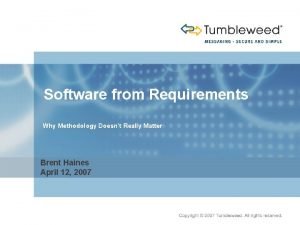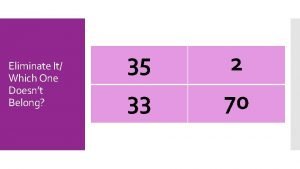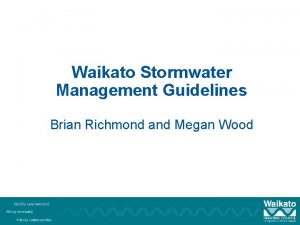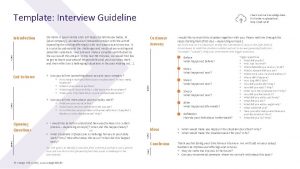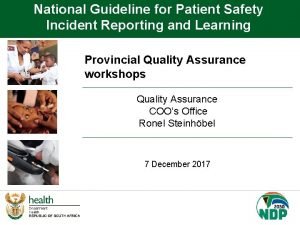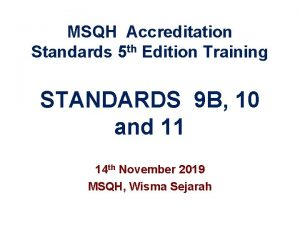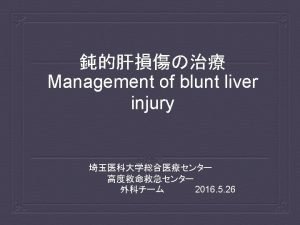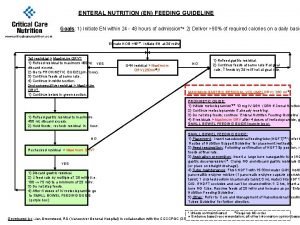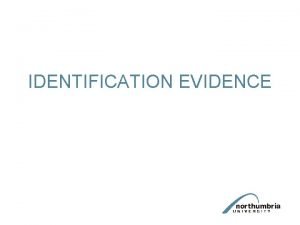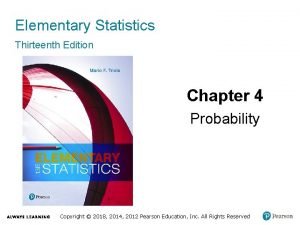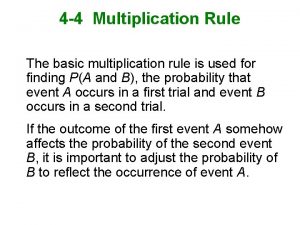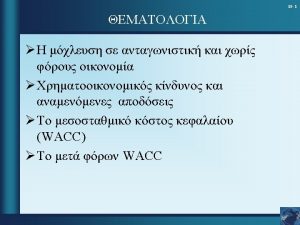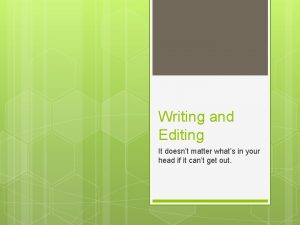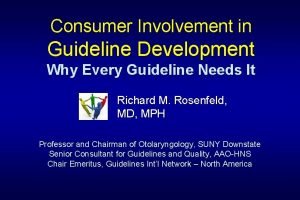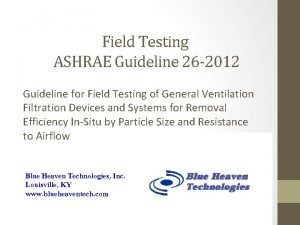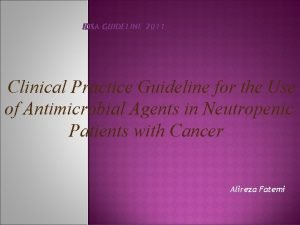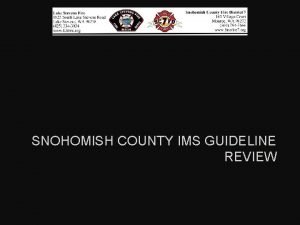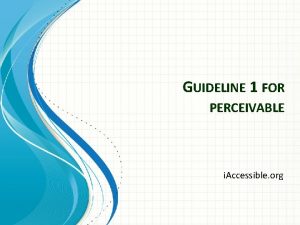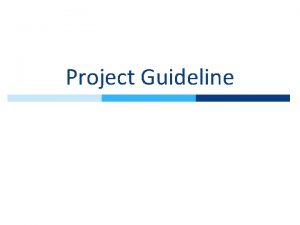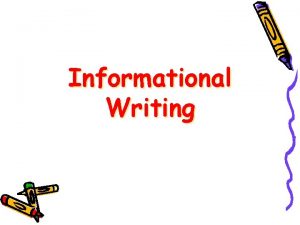Writing a Guideline or Policy It doesnt matter































- Slides: 31

Writing a Guideline or Policy It doesn't matter what your guidelines are, so long as everyone understands and sticks to them. It cannot be emphasized enough that guidelines are only useful if they are followed. –-R. Parman Deborah Bransford, BSN, CDE The Queen’s Medical Center dbransford@queens. org

Objectives n Define guideline n Identify steps for guideline development n Define Policy n Identify steps for writing a policy

What is the evidence telling us? n n n Critique Literature = merit n appraisal tool for reviews 6 n Excel spreadsheet Synthesize Literature Analyze & Synthesize recent research articles < 10 years worth analyzing < 5 years = focus

Weeding through n Organize by subject area Background and significance n Outcomes to measure n Intervention 1 n Intervention 2 n n Retain those that are relevant n High quality, consistent message, feasible

Literature Synthesis The final product will be a synthesis; a smooth blending of selected articles built around the key words/interventions of your study Hint: (1) on the spreadsheet use a column to match articles with interventions and (2) separate excel tabs for each intervention

Summary Synthesis n n Paragraph summaries to synthesize literature Use concept column of lit matrix to group summaries into like categories

Summary Synthesis Template Synthesis Matrix: Literature Reviews EBP Project: Synthesize Literature/Author Pre. Op Bg Control Paragraph summary -article 1 Paragraph summary-article 2 Paragraph summary -article 3 Paragraph summary-article 4 Intra. Op BG Control Paragraph summary -article 1 Paragraph summary-article 2 Paragraph summary -article 3 Paragraph summary-article 4 Post. Op Bg Control Paragraph summary -article 1 Paragraph summary-article 2 Paragraph summary -article 3 Paragraph summary-article 4 Hb. A 1 c Paragraph summary -article 1 Paragraph summary-article 2 Paragraph summary -article 3 Paragraph summary-article 4

Summary Synthesis Sample Synthesis Matrix: Literature Reviews Updated 11/2010 EBP Project: Perioperative monitoring and management of hyperglycemia as a preventive measure in reducing surgical site infection in joint replacement (Hip & Knee) surgery. Synthesize Literature/Author Pre. Op BG Control Risk Factors for Surgical Site Infection Following Orthopedic Spinal Operation By Olsen, M. A. , Nepple, J. J. , et al. In this retrospective case-control study, the authors found preoperative serum glucose levels were higher in patients who developed surgical site infection (SSI) after spine procedures. Preoperative serum glucose levels of > 125 mg/d. L was found to be an independent risk factor for developing SSIs. The article also discussed other independent risk factors such as diabetes, suboptimal timing of prophylactic antibiotics, postoperative blood glucose (BG) levels > 200 mg/d. L, obesity, and two or more residents assisting with procedure. The limitations of this study are inconsistent data collection regarding malnutrition and incomplete sequential serum glucose monitoring before and after surgery. Level of Evidence: IV (Mosby Grading Scheme) Literature/Author The Impact of Glycemic Control and Diabetes Mellitus on Perioperative Outcomes after Total Joint Arthroplasty By Marchant, M. H, Nicholas, V. A. , et al. This article was taken from a retrospective case study with quasi -experimental design. The results of this study indicated that patients with controlled diabetes mellitus (DM) had significantly lower risks for postoperative complications (stroke, UTI, ileus, postoperative hemorrhage, transfusion, wound infection, and death) as compared to patients with uncontrolled DM. The authors discussed that while hyperglycemia at time of admission is a predictor of complications, HB A 1 C levels have not shown to be an outcome predictor. However, they also cited an article that suggested HB A 1 C levels < 7 were related to lower risk of postoperative infections. Outliers, diagnosis coding, and data underrepresentation or misrepresentation were named as limitations to the study. Level of Evidence: III (Mosby Grading Scheme)

Now what? ? n n n Policy Procedure Protocol Practice Standard Comprehensive EBP guideline

Policy n n Background on “why” we should do something Includes frequencies of actions Tend to be facility specific Formal statement of the course of action to take n n n Uniform knowledge in order to promote consistent application. It need not be a an inflexible rule book. Rather it should be a resource for interpreting the variety of situations that can occur in the hospital. E. g. Nursing Policy for portable phones

QMC Nursing Policy Portable phones 1. Nurses are required to carry the phones at all times every shift. 2. At the beginning of each shift the Unit Secretary…. 3. Each occupied room is assigned to both a primary and secondary phone. 3. Phone assignments need to be recorded on the assignment sheet 4. If there is a ventilator alarm assigned to a phone …. 5. Phones and Breaks

Writing a Policy 1. Develop and Write the Policy With goals and samples in hand, write the policy using simple words and concepts. Speak directly to the people who will be reading, enforcing, and living by the policy. After each paragraph, ask yourself "what if" questions to make certain the policy is covering the basics and the normal exceptions and questions. 2. Review the Policy Select several employees, or even a small pilot group, to read the policy and ask any questions they might have about the policy. This review provides feedback that employees will be able to understand follow the policy. Rewrite the policy based on the feedback. 3. Obtain Management Support for the Policy Review the policy with the managers who will have to lead and put into effect the policy. You will want to have their support and ownership of the policy. You will have started this process much earlier, even as early as when you identified the need for the policy, but management support as you implement the policy is crucial.

Procedure n n n Can be used to implement policies Step by step direction on how to perform a task May be facility specific n manufacturer specific n n Setting up IV tubing – Hospira® pump May be global e. g. Foley catheter care

Algorithm Can be part of the policy, procedure guideline or protocol Different way of documenting the content

Protocol n Regulatory/accrediting implications n n often directly associated with a course of action formally approved by the facility and the use of standing orders. Give staff the authority to act on behalf of agreed upon orders.

QMC Adult Emergency Protocol Chest Pain Administer supplemental 02 Apply continuous pulse oximetry – maintain Sa 02 > 92% Obtain stat 12 lead EKG Give NTG 1/150 tablet SL, if BP > 100 Stat page IVT for large bore access Etc…….

Practice Standard Similar to a protocol: A reference point against which other things can be evaluated (comparison) May set a measure for all subsequent work n Standards create an expectation n n E. g. “We will obtain an MRSA screen on all patient on admission” Practice standards are thought to be a bit more flexible.

= a decision Point Assemble Relevant Research & Related Literature Critique & Synthesize Research for Use in Practice Yes Pilot the Change in Practice 1. Select Outcomes to be Achieved 2. Collect Baseline Data 3. Design Evidence-Based Practice (EBP) Guideline(s) 4. Implement EBP on Pilot Units 5. Evaluate Process & Outcomes 6. Modify the Practice Guideline Is There a Sufficient Research Base? No Base Practice on Other Types of Evidence 1. Case Reports 2. Expert Opinion 3. Scientific Principles 4. Theory Conduct Research

Guidelines n n n Created by professional organizations, societies, health care organizations, or government agencies using verifiable, systematic literature searches and reviews of existing evidence published in peer-reviewed journals to establish best practice recommendations Systematically developed statements to assist practitioner & guide decisions about appropriate health care for specific clinical circumstances Used to improve patient care and as a potential solution to reduce inappropriate variations in care

Guideline, contd. n n n Preferred…but that does not have the force of a standard The use of guidelines requires the provider's clinical judgment. For that reason, the guidelines may be viewed as an educational tool to provide information and assist decision making Guidelines should be evidence-based (referenced) and based upon explicit criteria to ensure consensus regarding their internal validity

Characteristics of GLs applicable - the target 1. Valid - rigorously developed and 6. Clinically population should be defined consistent with available evidence. 2. Cost effectiveness - the improvements in health care should have acceptable costs. 3. Reproducible - given the same evidence, another guideline development group would produce similar recommendations 4. Reliable -given the same clinical circumstances, another health professional would apply the recommendations in a similar fashion 5. Representation from all key disciplines and interests, including patients. 7. Clinically Flexible by identifying exceptions and how patient preferences are to be taken into account 8. Clear - using precise definitions and user friendly formats. 9. Meticulous documentation of the guideline development process: who took part, methods used, and assumptions made, and should link recommendations to the available evidence, which should be graded. 10. Reviewed periodically and modified to incorporate new knowledge.

Advantages of GLs n Evidence-based reference for provider practice n n n Linkage with n n Benchmark for measuring performance Comparison between agencies easier using similar guidelines improvement in patient clinical condition and outcome reduced risk of morbidity and mortality enhanced patient safety Provides a clear understanding of expectations and responsibilities.

Potential Disadvantages of GLs n n n Difficult and resource-intensive to develop and maintain Minimal flexibility for individual preferences, agency capabilities, changes in patient condition Difficult to establish for patients with multiple, complex diagnoses May be too vague to be useful or too narrow to be legally "safe" Might force provider to meet unrealistic expectations regarding equipment, education, and maintenance of skills Guidelines do not have the most force and effect.

Check out what others have done n n Facility “standard” What matches your needs Style………. . Length………. Friendly Content is always different

In summary EBP Guidelines n n Referenced Written guide of evidence-based healthcare practices/evidence Identify the strength of the evidence Contents vary: n n Brief description of the topic Types of patients the GL is used for Assessment and interventions used to carry out the GL Risks/benefits of the GL

Suggested Process For Clinical Guideline Development

What Makes a Good Guideline? n Recommend that you critique your guideline draft using the AGREE Tool to assess for missing components before finalizing

EBP Guideline Template Refer to handouts

Getting Approval

Getting Approval (cont)

Questions
 Doesnt really matter
Doesnt really matter Why does holden fight stradlater
Why does holden fight stradlater What goes up and doesnt come down
What goes up and doesnt come down What does dna have that rna doesnt
What does dna have that rna doesnt Doesnt affect me
Doesnt affect me Which one doesn't belong?
Which one doesn't belong? King henry doesnt usually drink chocolate milk
King henry doesnt usually drink chocolate milk Dont tense
Dont tense Stuart gitlow
Stuart gitlow Classification of matter section 1 composition of matter
Classification of matter section 1 composition of matter Function of grey matter and white matter
Function of grey matter and white matter Section 1 composition of matter
Section 1 composition of matter Chapter 2 section 1 classifying matter answer key
Chapter 2 section 1 classifying matter answer key Median and lateral apertures
Median and lateral apertures Section 1 composition of matter
Section 1 composition of matter Gray matter and white matter
Gray matter and white matter Gray matter vs white matter
Gray matter vs white matter Energy naturally flows from warmer matter to cooler matter.
Energy naturally flows from warmer matter to cooler matter. Waikato stormwater management guideline
Waikato stormwater management guideline Interview guideline template
Interview guideline template Anemia in pregnancy guideline
Anemia in pregnancy guideline Guideline anamnesa
Guideline anamnesa National guideline for patient safety incident
National guideline for patient safety incident Msqh guideline
Msqh guideline Pertanyaan anamnesa psikologi
Pertanyaan anamnesa psikologi East practice management guidelines
East practice management guidelines En feeding guide
En feeding guide Chapter 16 milady review questions
Chapter 16 milady review questions What is a guideline for hoisting a hoseline?
What is a guideline for hoisting a hoseline? When do the turnbull guidelines apply
When do the turnbull guidelines apply 5 guideline for cumbersome calculations
5 guideline for cumbersome calculations Formal multiplication rule
Formal multiplication rule
